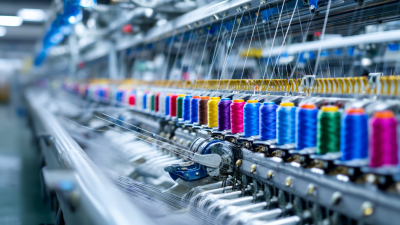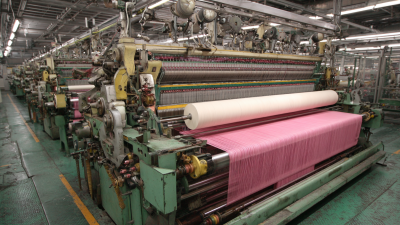Leave Your Message
In the ever-evolving landscape of modern manufacturing, the role of Textile Industry Machines stands as a cornerstone for efficiency and innovation. Experts like Dr. Emily Carter, a leading authority in textile engineering, emphasize that "the integration of advanced textile machinery not only enhances productivity but also elevates the quality of the final products." This notion underscores the vital importance of these machines in streamlining processes and meeting the increasing demands of consumers in the textile sector.
As manufacturers strive to optimize their production capabilities, the significance of Textile Industry Machines becomes even more pronounced. These machines are not merely tools; they embody the technological advancements that drive the industry forward. From automated weaving systems to cutting-edge dyeing technologies, each development reflects a commitment to improving speed, sustainability, and quality in textile manufacturing.
Furthermore, the current trend towards smart manufacturing integrates Internet of Things (IoT) technology with Textile Industry Machines, paving the way for real-time monitoring and data-driven decision-making. This evolution not only enhances operational efficiencies but also positions manufacturers to respond swiftly to market changes. In a world where agility is paramount, the importance of Textile Industry Machines has never been more critical.

The evolution of textile industry machines has been a pivotal factor in shaping modern manufacturing processes. From the simple hand-operated looms of ancient times to the industrial revolution's mechanized spinning jennies and power looms, each innovation marked a significant leap in productivity and efficiency. The introduction of steam power in the 18th century further accelerated this transformation, allowing for faster production and lower costs. As technology advanced, the integration of electricity and computerization revolutionized textile manufacturing, turning it into a highly automated and precision-driven industry capable of producing complex fabrics quickly.
In recent decades, the evolution of textile machines has not only enhanced production capabilities but also improved the quality and variety of textile products available in the market. The advent of computer-aided design (CAD) and automated cutting machines has allowed for intricate designs and customizations, catering to consumer demands more effectively. Innovations such as 3D knitting and digital printing have further expanded the creative possibilities within the textile sector, enabling manufacturers to respond swiftly to trends while minimizing waste. This historical perspective highlights how advancements in textile machines have continually transformed the industry, leading to a dynamic and competitive environment in modern manufacturing.

In recent years, the textile industry has witnessed significant technological advancements that have transformed modern manufacturing processes. One of the key innovations is the introduction of automated weaving and knitting machines. According to a report by MarketsandMarkets, the global textile machinery market is projected to reach USD 41.0 billion by 2025, growing at a CAGR of 4.9%. This shift towards automation has not only increased production speed but also enhanced fabric quality, allowing manufacturers to meet the evolving demands of consumers for diverse and complex textile products.
Moreover, advancements in digital technology, such as computer-aided design (CAD) and digital printing, have revolutionized the textile manufacturing landscape. The adoption of these technologies enables designers to create intricate patterns and designs with precision, reducing time and material waste. A study published in the Journal of Textile Science indicates that companies utilizing digital printing can achieve a reduction of 30-50% in dye consumption compared to traditional printing methods. As a result, modern textile machinery is not only streamlining production but also contributing to greater sustainability within the industry.
The integration of smart technologies and data analytics further allows manufacturers to optimize their workflows, leading to improved efficiency and cost-effectiveness.
The textile industry has undergone significant transformations with the introduction of automation, which plays a crucial role in enhancing production efficiency. Automated machinery, such as weaving and knitting machines, allows manufacturers to produce fabrics at a faster rate while maintaining consistent quality. By reducing human intervention, these machines not only minimize errors but also lower labor costs, enabling companies to allocate resources more effectively.
Moreover, automation facilitates a more streamlined production process. Advanced technologies, including computer-aided design (CAD) and robotic systems, enable better inventory management and quicker responses to changing market demands. This agility is essential in today's fast-paced fashion landscape, where trends can change rapidly. As a result, businesses equipped with automated textile machines are better positioned to meet the needs of customers while optimizing their operational efficiency and sustainability.
The textile industry has been undergoing a significant transformation with the integration of sustainability trends, focusing on eco-friendly manufacturing practices. Modern textile machinery plays a crucial role in this shift, enabling manufacturers to reduce waste, conserve energy, and minimize their carbon footprint. Innovations such as water-efficient dyeing technologies and energy-saving looms are just a few examples of how machinery advancements contribute to a greener production process.

When considering sustainable textiles, it’s essential to choose machines that are designed with eco-efficiency in mind. Here are some tips for manufacturers looking to embrace sustainability:
The importance of textile industry machines in driving sustainability cannot be overstated. By harnessing cutting-edge technologies and implementing eco-friendly practices, manufacturers can lead the way towards a more sustainable future in textiles.
The textile industry is on the verge of a transformation, driven by advancements in Artificial Intelligence (AI) and the Internet of Things (IoT). By 2025, manufacturers are expected to integrate these technologies to enhance operational efficiency, reduce waste, and improve product quality. AI will enable predictive maintenance for machines, ensuring they operate at optimal performance, while IoT will facilitate real-time monitoring of production processes, allowing for quick adjustments and more informed decision-making.
Tips for manufacturers looking to adopt AI and IoT: Start small by implementing IoT sensors on high-value machinery to gather data and analyze performance. This can provide insights into maintenance needs and operational bottlenecks. Additionally, consider partnering with tech companies specializing in AI solutions to customize algorithms that fit the specific requirements of your production line.
Moreover, embracing these technologies will not only streamline operations but also enhance sustainability efforts. With AI-driven analytics, manufacturers can optimize resource usage and minimize environmental impact. This alignment with eco-friendly practices is not just a trend; it’s becoming a necessity in the competitive textile market. Investing in AI and IoT now could position your business as a leader in the industry's future.






